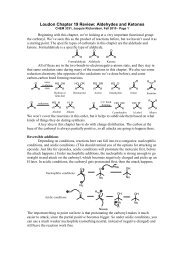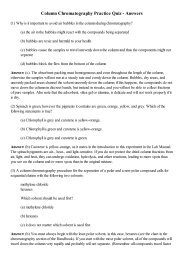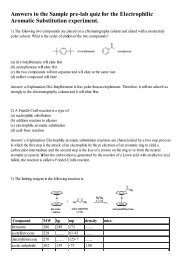7 - Isolation of Limonene.pdf
7 - Isolation of Limonene.pdf
7 - Isolation of Limonene.pdf
You also want an ePaper? Increase the reach of your titles
YUMPU automatically turns print PDFs into web optimized ePapers that Google loves.
Experiment 7: <strong>Isolation</strong> <strong>of</strong> <strong>Limonene</strong><br />
mixture, is normally between the boiling points <strong>of</strong> the individual components. This was the case for the<br />
Simple and Fractional Distillation experiment performed previously in this class.<br />
A heterogeneous mixture <strong>of</strong> two immiscible liquids will also boil when the combined vapor pressures <strong>of</strong><br />
its components is equal to the surrounding pressure. However, because the liquids are immiscible, the<br />
vapor pressures <strong>of</strong> the individual components are independent <strong>of</strong> one another and not related to their<br />
concentrations. The two liquids independently exert vapor pressures against the external pressure, and<br />
when the sum <strong>of</strong> the partial pressures is equal to the external pressure, boiling occurs. Thus, the total<br />
vapor pressure <strong>of</strong> a heterogeneous mixture is given by the following equation:<br />
Ptotal = P° A + P° B<br />
where Ptotal is the total pressure <strong>of</strong> a system at a given temperature, and P° A and P° B are the individual<br />
pressures <strong>of</strong> components A and B at the given temperature. Generally, a heterogeneous mixture will boil<br />
at some temperature below the boiling point <strong>of</strong> either component. In Figure 7.3, individual vapor<br />
pressures are plotted against temperature. Pure compound B, which has the lower boiling point, will boil<br />
at a temperature slightly above 125 °C. But when compound A is also present, the combined pressures<br />
add up to 760 mm—and the mixture boils—when the temperature is about 85 °C. This boiling<br />
temperature is lower than the boiling point <strong>of</strong> either compound alone, and it is the result <strong>of</strong> the<br />
combined effects <strong>of</strong> both compounds.<br />
vapor pressure curve for pure A<br />
38<br />
T (˚C)<br />
125<br />
100<br />
75<br />
50<br />
25<br />
200<br />
400 600 800<br />
vapor pressure<br />
curve for pure B<br />
P (mm mercury)<br />
Figure 7.3 » Effects <strong>of</strong> combined pressures in heterogeneous distillations.<br />
We can take advantage <strong>of</strong> the fact that many water-insoluble liquids and solids behave in the manner<br />
described above for heterogeneous mixtures, volatilizing at temperatures below their boiling points. The<br />
effect described above is exploited in a technique called steam distillation, where an organic compound<br />
<strong>of</strong> moderate volatility and vapor pressure is distilled as part <strong>of</strong> a heterogeneous mixture with water. The<br />
boiling point <strong>of</strong> the mixture is slightly below 100°C, the boiling point <strong>of</strong> water. At this temperature, a<br />
fraction <strong>of</strong> the distillate will be the compound <strong>of</strong> interest. The greater the vapor pressure <strong>of</strong> the organic<br />
compound, the larger the fraction that will co-distill with the water. This technique is considerably<br />
gentler than regular distillation, since some organic compounds can decompose at temperatures<br />
approaching their true boiling points.<br />
Since the amount <strong>of</strong> water is constantly decreasing during the procedure, a steam distillation is<br />
performed with the frequent addition <strong>of</strong> small amounts <strong>of</strong> water. Traditionally, this is done by using a<br />
setup similar to that shown in Figure 7.4. A separatory funnel is placed above the round-bottom flask<br />
and is used to add water to it.













